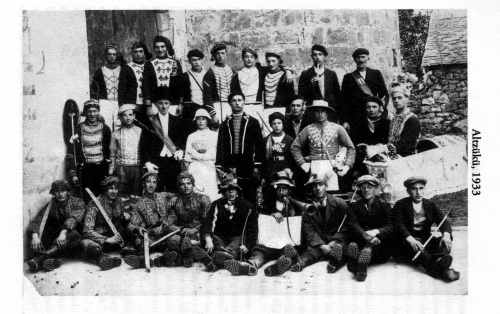Notes on the traditional basque carnival
- Txema HORNILLA
- 13/ 11/ 2001
The article begins by interpreting the festival of Carnival as a contrast to the celebration of Lent. Carnival is then analyzed from a psychological and sociological viewpoint. The next section refutes the previous ones while attempting to relate the festival to pre-industrial and even prehistoric concepts. Christianity, as the official religion of the Holy Roman Empire, was a new milestone when establishing the meaning of previous pagan festivals. Nonetheless, in Carnival an almost universal structure and symbology which is oriented towards initiation rites of youth can be seen repeatedly. Finally, the subject of European youth associations is brought up and analyzed in relation with the Basque celebration of Carnival.
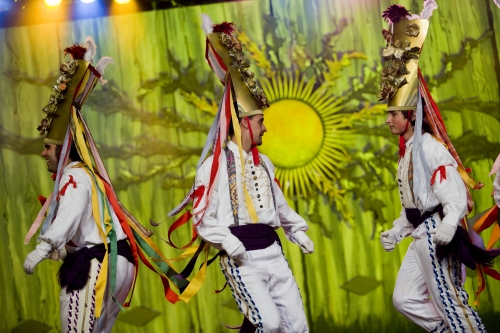
A first glance at carnival
In the strictest sense, Carnival is a Christian festival which was added to the calendar with a clear purpose: to exalt, by contrast, Lent and Christian values in life. However, in Christianity's most traditional forms Lent has always been continuous; we could say that all our lives we observe Lent. With so much restriction, it must have seemed necessary to allow three days a year for the outlet of feelings and passions at the base of human nature. Carnival can thus be described as the "weekend" of Christianity.
How have they interpreted Carnival, the mask, the dances, the festival, etc. from a psychological and sociological viewpoint? Carnival (in general, the celebration) has been considered by sociologists to be a "slave rebellion" and modern psychology has regarded the festival as an outburst of impulses, normally those which are suppressed. The two concepts coincide in many points; whether it is at an individual or collective level, they both point out the celebration as a eruption of pent-up tensions which for an instant find their way to the surface in a controlled fashion. The liberties taken at Carnival, such as the "festivals of madmen" and other similar ones, are only a permitted "outlet", a passing, and authorized rebellion to maintain day-to-day order with a lesser risk of collapse. Expressed in the terminology of an equally modern philosophical movement, it is all about changing some elements so that the structure remains complete and unchanged. In short, psychologists consider Carnival to be the "weekend" of morality and sociologists consider it to be the "weekend" of the class struggle.
The sociologists and psychologists are right. However, their theory must be regarded as certain or almost certain when applied to "historical" societies, i.e., those that have a diachronic structure and are based on a "docile" type of thinking aimed at obtaining efficiency (Lévi-Strauss) or at obtaining productivity with benefits for those who control the structure (Marx). On the other hand, the theory "would only have a flaw - besides being wrong" if it were applied to "prehistorical" societies: it does not take into account that in the case of these societies there was little or nothing to be gained with respect to daily order.
The influence of Christianity reaches that other place: the world of traditional cultures and the cultures of pagan peoples, on which it acted in two complementary ways. First it modified its message: if we compare those "primitive" traditions with a language, Christianity permitted the continuity of the syntax in a certain fashion but only in return for compromising the semantics. This way they tolerated the free movement and exchange of the signifiers but they unified the possible use of the meanings by introducing a single code of interpretation: the symbol became a sign and a signal. The second transformation involved a reduction of space and time: those "pagan" beliefs and customs, now infused with a new message, are the ones which were squeezed into dates which nearly coincided with those of Carnival. It is thus uncomplicated to discover that this festival and its different variants (already unified all over Europe and its area of influence) had many coincidences with events that occur in other classical festivals and with the rites of the conquered peoples. Therefore it is no surprise that the essence of Carnival includes many primitive evocations, rites and myths which have passed unaltered through time. This is also true of the structures up to a certain point, but we are speaking about structures of the mind, archetypes which have become somewhat timeless and of which we are not fully aware unless we analyze them.
This last point seems particularly evident when we analyze the traditional Carnival that concerns us: Iñauteri, Ihauteri, the Traditional Basque Carnival. In reality, the Basque culture is, like many others, a historical and Christianized culture, so its "Carnival" logically has many festive elements. However, in the studies which we have performed we were never interested in determining the "carnival" aspect of Ihauteri, but rather in discovering the rites and "primitive" myths which it contains and their possible meaning. Ours is not the only attempt at this; other authors (e.g. Gaignebet) have made similar tries by studying other peoples and cultures, although perhaps they achieved different results. At this point it is necessary to make a point: through the study of Basque culture it is also possible to discover a type of universal thinking which is likewise able to explain some of the inner reasoning behind the classical festivals and Christian Carnival itself. This is because the very thing behind both of them is that magical form of thinking, which resists disappearing completely and which, in spite of everything, only managed to remain as a certain "symptom", "madness" or "unease" in the culture - understood as THE culture, the official one.
Rites of puberty
The working hypothesis which I have proposed in the interpretation of the traditional Basque carnival has entailed supposing that those archaic rites are principally based on the idea of initiation in death and resurrection at different levels, but above all in the "strong" or ethnological sense.
In reality I based my work on a somewhat ironic framework, as I based it on an approach that was close to that of positive natural science. In effect, in natural science the main difficulty lies in limiting the field of objects to later determine laws that relate them in a specific manner. I also wanted to approach Ihauteri by establishing a specific field of objects, attempting to find the laws that join almost all the points and which were stated in the hypothesis. The development of the hypothesis allowed me to articulate Ihauteri around a theory in which the different expression (e.g., giants and people wearing masks) were joined by their inclusion in a very precise logic.
Perfectly described by Eliade in full detail (as well as by Frazer and other authors to a lesser extent), the rite of initiation basically consists of the symbolic death and resurrection of the pubescent young people, who thus abandon (die) the feminine world of infancy and become part of (resuscitate) the world of adult males.
The rite essentially aims to make them believe that they will die (devoured by a monster, a sacred animal, etc.) to resuscitate later thanks to the support of man. The atmosphere is carefully prepared so that the neophytes feel terrified and really think that destiny is hovering over them. When the decisive moment arrives, amidst a great deal of anxiety suffered by the young people while waiting to perish, the men explain that it was all a lie. After asking them not to reveal anything to the women or children (the uninitiated), the elders divulge the religious secrets of the tribe to them.
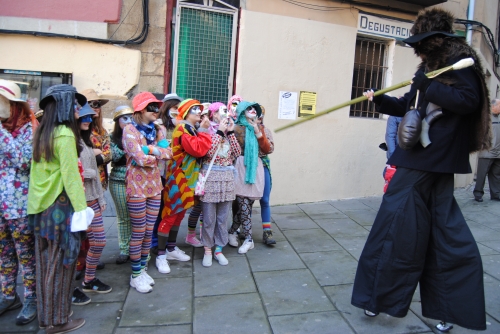
The diverse trials which they must undergo during this transition seem to coincide in many aspects with elements of Carnival. An application of the comparative method made it possible for me to verify this with relative ease. These trials include a good many examples of ill-treatment: the young people are forbidden to sleep, to eat, to drink and are tossed around in the air; they have to cross thickets, climb certain trees, remain silent and eat without using their hands; they are covered with blankets, dry branches, etc.; they are covered with excrements or they are blindfolded. Fire and ants are thrown at them, they are "toasted", they are kidnapped while the men take over the village in terrifying manners while throwing burning branches and filling the village with smoke. They are forced to drink nauseating beverages and they are insulted, chased and bitten. At times they must witness bloody spectacles are they are asked to participate in them. Frightened, they refuse until they discover that it is all a farce and the blood is not real, etc.
Many of these cruelties which the neophytes must go through, the deceit with the women and the uninitiated, who must never discover the secret truth behind the farce and the initiation-related meaning behind the transvestite costume seem to still have an underlying presence in certain stagings of Ihauteri. For example, in nearly all the villages of the Basque Country which have maintained customs and beliefs linked to rural areas Carnival provides a reason for some groups of young adults to go around with masks. They spend part of their time chasing children and young adolescents, at times making them support a great deal of ill-treatment. In addition, they force them to undergo trials which at times are relatively harmless, but at others are in very bad taste. These groups of masked men receive a variety of names, although almost all of these names can be put in the same etymological group. After what should be considered their primary function, which is to chase children, they also perform curious pantomime shows. However, both actions can be related to the initiation structure which we assume to be behind these acts: games that oblige children who are trapped to eat without using their hands ("higuico" and others), chases, blows with a "putxika", a whip or a stick, soakings, being covered with mud or excrements, being pinched with pincers or other instruments made expressly for that purpose, "perverse" kisses, passing literally through a ring, suffering frights caused by certain situations or instruments and medieval rites in which blood does not really flow or does so artificially. These are all common elements of Ihauteri. The initiation of being "covered" with hides, the silence demanded of the young men, the imitation of animal sounds and the symbolic ritual incisions are recurring aspects. In Lanz the Ziropot reminds us of those young people in other cultures who must undergo initiation rites. Stuffed in a mound of straw which barely lets them walk, with their faces covered and amidst a deafening screams, the young men feel the blows and jostles which knock them down throughout their route.
Here we can also find what can be considered to be a central part of the initiation. In reality it deals with representing the myth of the origin as accurately as possible. The tribe was established by a god, hero-animal, mythological ancestor or monster who himself died and resuscitated, creating a new and superior form of existence. The neophytes repeat this process. The central part generally involves the performance of bloody tasks and indoctrination in the tribal traditions. This way they also regenerate the sacred Time. It is no coincidence that these rituals, like those of Carnival, are always celebrated at the end of winter or the beginning of spring, when nature is also regenerated. On many occasions the ancestral creator himself - simulated with a mask, a figure or an icon - is the person responsible for killing, gobbling, etc. the neophytes, uniting their destiny with his. His terrifying voice is felt in the hoarse sound of a bellowing. Circumcision, the extraction of a tooth, the amputation of a finger or cutting different parts of the body are his "mark" and an unequivocal sign of his existence at the same time.
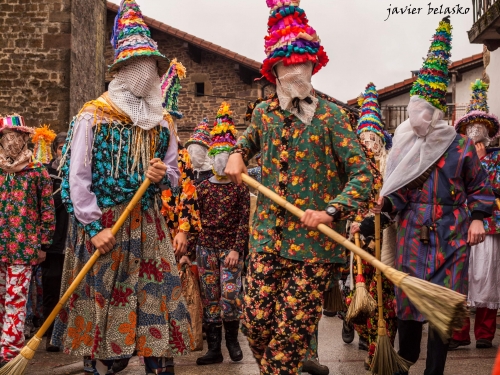
There are diverse elements which all seem to lead again and again, almost insistently, to the archetype mentioned previously: a (still prudent) analysis of the names of Carnival and its figures, as well as of the term Ihauteri itself (which may refer to group circumcision); the existence of the bellowing (= eltzaorra = roar of death?); the symbology of the traditional figure and the burning of it, which goes back to the genies of mythology (heathens, "Basajauna", "Olantzero", "Tártalo" ...), some of whom are linked to the story of a boy-hero who must watch horrified as one of his companions is skewered, roasted and eaten by the giant and who only escapes from the same fate by wearing the hides of certain animals, the entire set of elements in themselves constitute a very transparent theme of initiation. The archetype, by the way, has revived in a totally unknowing way but, curiously enough, in the figure of that terrible giant who still devoured us in our infancy, opposite the Arriaga Theatre in Bilbao. It is equally curious that in Gascue, for example, the children chased by the "txatxuk" mentioned fingers and teeth in their songs...
HEROIC INITIATIONS
Beyond the rites of puberty, we must refer to a particular type of initiation: heroic initiation. Passing this initiation means that they are cut out to form part of a secret brotherhood of warriors (Männerbünde) or to achieve a special state of grace (in the case of the shamans, warriors and blacksmiths).
As in any initiation, he who aspires to be a "männerbünd" or achieve a mystical personality must subject himself to the mystery of death and resurrection. Therefore, what truly distinguishes the heroic initiation is the regressus ad uterum or the descensus ad Infero of the candidate in order to achieve immortality. The hero must return to the womb of the Great Mother to deal with the dangers that are found there. The Earth appears in this symbolism as the goddess of Death and the Lady of the dead (Eliade). The real, underlying meaning is a fear of women; female sexuality and maternity were terrifying for primitive men. Therefore, the hero must be capable of entering the uterus and get through, unharmed, its intricate and chaotic labyrinths full of danger. This is one of the tests for the dead: he who succeeds will become part of the community of the Forefathers. Like them, he has become immortal.
The real structure of the heroic initiation follows a relatively unaltered model: the uterus of the Mother is represented with a "circular field" or a "triangular field". The cabin of initiation is also used to this end and in distant times they also took advantage of caves and natural crevices for the same purpose. There the candidates had to demonstrate their ability and their resistance to pain. The Forefathers are represented with masks, especially animal masks, and the neophytes themselves must undergo a transformation and become wild animals. In Europe the members of the Männerbünde became wolves, bears or foxes, causing fear amongst women and those who did not know the secrets of the group. They thus made their brotherhood with animals of prey evident by exercising a certain right to steal and carried out theft of livestock during their incursions at the end of winter.
Close to the phenomenon of lycanthropy is the theme of mystical fervour, the enraptured frenzy of the warrior or shaman. Changing his human condition, the hero "ignites" and he "becomes feverish", feeling overcome by a mysterious, overpowering force which flows out from the innermost parts of his sacred essence. The warrior and the shaman are thus the "Lords of fire". However, it is evident that another Lord of fire is the blacksmith, who we must place in this symbolic and religious context: he works with the same fire that the chosen men obtain in their interior through the "wut". This explains the important presence of the blacksmith in rituals like the Männerbünd, for example. Chosen by the forefathers to pass on their science and mysteries, he will brand the horse-figure by "killing" it and immediately "reviving" it, now full of heat and possessed by a terrible magical force. In Scandinavia and northern Germany, branding was an obligatory rite in order to enter the Secret Societies of men. The coincidence in the intrinsic nature of the Hero with his Forefathers is expressed in the form of heat.
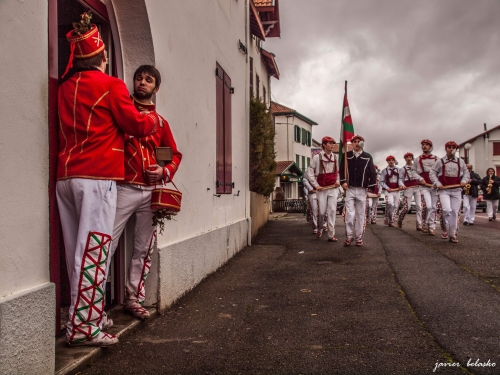
The rural Carnival of the traditional Basque culture contains many "remnants" of these rites: there are numerous groups of young people who create terror amongst women and children as described above; they keep their identity secret through the use of masks; they imitate the behaviour of foxes or wolves by stealing farmyard animals; they demonstrate their ability as warriors or horse riders, which is related to the prior point as they do so by beheading certain birds; they perform sword dances and other special dances and they "occupy" villages on certain holidays. Later, leaving Carnival somewhat aside although at times related to it, there are brotherhoods of guilds (stonemasons, blacksmiths) who pass on "professional secrets" or use secret languages. Certain masked people also use secret languages... Ancient means of heroic initiation can still be seen in the "Masquerades" of Zuberoa or in the "Axeri dantza" of Aduna, for example, and in other villages of Guipúzcoa. At some moment of the northern dances, "Entseñaria" and his shaman allies penetrate in the circular field; the ends of the chain which delimits it bend in to trap them without success - they are closed off but they manage to escape miraculously with their incredible leaps. Then "Zamalzain" is branded; nobody can hold him down and he limps, showing the mark of his initiation. The "foxes" of Aduna steal in the country homes and later they meet in the square to perform pantomimes which were once initiations: the "buruzagi" puts oakum into his nose, lights it and singes them, they cross through a ring of fire and they are branded. In the dance of the "Orratzakoa" they form a single file with their legs spread apart. Each of them must go through this tunnel while being stamped on and hit; the person going through tunnel barely manages to defend himself with a needle "= "orratza") he holds during his crawl on all fours. When he reaches the end, the dancer who is at the front of the line lifts him by his underarms and takes him out from between his legs as if he has given birth to him. The "Azeri dantza" ends with the game of roosters (oilar jokue). The "foxes" must demonstrate their ability as mounted warriors in the centre of the square.
The sun heroes of Basque mythology (Kanillo, Kukubiltxo and others) likewise present symbolic structures with clear references to this model of initiation (being devoured by a fish, battles against the devil or forces of evil and the final victory). The roots of Ihauteri are more archaic (and arcane!) than realist authors suppose.
THE MASQUERADES OF ZUBEROA
To make the ancientness of this trial more evident, we must analyze the Masquerades of Zuberoa, thus passing from the whole to a part. The "Masquerades" are undoubtedly the representation of the Basque Carnival which has merited the greatest amount of interpretations and comments from scholars. This is not a coincidence; the complicated movements of the dancers, the animal character of many of them and their strange pantomimes constitute an ocean of symbols and a "labyrinth" whose primitivism is quite evident.
We cannot stop here to describe all the characters, who are already well known, in these Masquerades. Perhaps it would be sufficient to remember how the structure of the Masquerades is formed by a system of opposing groups and basic contrasts. It is easy to understand the division between "reds" and "blacks", each of which represents multiple antagonistic concepts with respect to the other. Nor do I wish to spend an excessive amount of time on the previous interpretations which I examined. We must admit that anterior Basque authors who analyzed the problem did so with excessive superficiality and based on prejudices which are regarded as inacceptable today. Other interpretations performed by non-Basque authors did not improve on them although they demonstrated a little more "ingenuity". For example, Violet Alford applied Frazer's magical-animist theories, trying to discover through Soule a strange dance of spirits of the vegetation. It is more interesting to analyze the fact that they have also suggested the possibility that these representations were remains of a primitive totemic organization in the villages; this idea was immediately rejected (cf Caro Baroja). I decided to follow this line of thinking although it was quite "countercurrent". If we considered the classical theories about totemism it was difficult to draw conclusions or fit the Masquerades within the system, but the most modern conceptions of totemism, particularly those set forth by Lévi-Strauss, provided me with an important instrument of analysis.
Applying the method of structural analysis with the Masquerades, i.e., performing a vertical interpretation, I was able to see them as a true form of totemic thinking - a "wild thinking", a natural logic of multipurpose symbols which is based on the contrast of terms and which aims to maintain a coherent social order, amonst other things. In this sense we could also mention exogamy as the meaning of the representation: basing the idea on natural diversity, the men establish cultural differences of very diverse levels amongst themselves, establishing a system of transactions which unite and organize society. Continuing along the same (vertical) line, the Masquerades could be regarded as the regional expression of a view of the world whose purpose is to feed on itself, resisting the impetus of historical evolution, or as an expression of the structure in the face of events, of synchrony as opposed to diachrony. All of this inspires a very singular notion of time: a time folded over itself, made into space, a circle similar to a black hole, capable of swallowing any yearning for renovation which is not cyclical or periodical.
A second interpretation, now horizontal, places the masquerades once again in contact with the rite of initiation - an initiation of puberty, on the one hand, but above all a shamanic initiation. The main dancers of Soule present the figure of the sorcerer. Zamalzain, the horse-man, is a shaman who symbolically descends to Hell to obtain the magic and sacredness from the Great Mother Earth. Some myths, rites and symbols of the traditional Basque culture confirm that the example of Zuberoa is not an isolated one, because the shamanism is also addressed in a particular way in them. This shamanism, attributable to the primitive Basques, has different themes which lead one to think they are the result of a mix of diverse cultures. Matriarchal cultures of farmers and patriarchal cultures of hunters merge here and each of them leave their primary characteristics.
This small compilation of data offers a quick summary of my interpretation of the traditional Basque Carnival. To be honest, this ethnological reconstruction would in itself be reason enough for me to be included amongst the heretical citizens of Basque anthropology. Lastly, I would like to express my gratitude to Juan Garmendia Larrañaga; without his unexcelled ethnographical work none of my research would have been possible.
BIBLIOGRAPHY
The most important elements of the author's bibliography about this topic: HORNILLA, T. (1987): Sobre el carnaval vasco. Txertoa, San Sebastián; HORNILLA, T. (1988): Zamalzain el chamán y los magos del carnaval vasco. Txertxoa, San Sebastián; HORNILLA, T. (1989): La mujer en los ritos y mitos vascos. Txertxoa, San Sebastián; HORNILLA, T. (1991): Los héroes de la mitología vasca. Antropología y psicoanálisis. Mensajero, Bilbao, and, above all, HORNILLA, T. (1990): El Carnaval vasco interpretado. Mensajero, Bilbao. About initiation: ELIADE, M. (1975): Iniciaciones místicas. Taurus, Madrid, and ELIADE, M. (1982): El chamanismo y las técnicas arcaicas del éxtasis. Fondo de Cultura Económica, Mexico.
